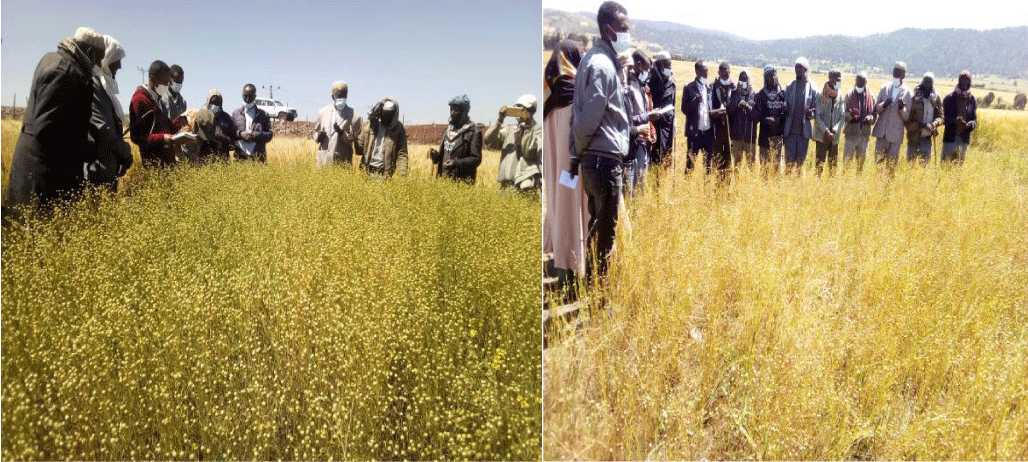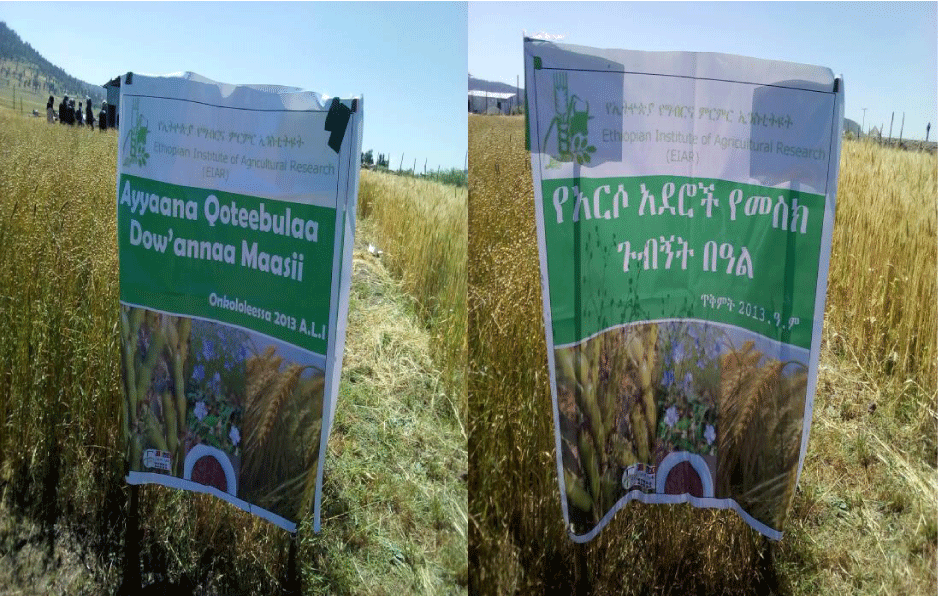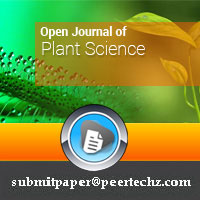Open Journal of Plant Science
Participatory evaluation of Linseed (Linum usitatissimum L.) varieties under farmers training center at Dodola District of West Arsi Zone, Oromia Regional State, Ethiopia
Sintayehu Abebe*, Marta Gichamo, Alemu Doda and Birhanu Sime
Cite this as
Abebe S, Gichamo M, Doda A, Sime B (2022) Participatory evaluation of Linseed (Linum usitatissimum L.) varieties under farmers training center at Dodola District of West Arsi Zone, Oromia Regional State, Ethiopia. Open J Plant Sci 7(1): 014-019. DOI: 10.17352/ojps.000046Copyright
© 2022 Abebe S, et al. This is an open-access article distributed under the terms of the Creative Commons Attribution License, which permits unrestricted use, distribution, and reproduction in any medium, provided the original author and source are credited.The study was carried out in the Dodola district of West Arsi Zone, Oromia regional state, Ethiopia. The aim of this study was to evaluate the performance and farmers varieties preference of Linseed at Alantu kebele within the Farmers Training Center (FTC) demonstration plot of Dodola district of West Arsi Zone. Along with their management practices under the Farmers Training Center (FTC) field to enhance farmers’ knowledge and skill on Linseed production performance. The verities used to demonstrate were, improved Linseed varieties namely Kuma, Yadano, Bekoji-14, Kulumsa-1, Kassa-2, and Local check.
According to the results, an average yield of 22qt/ha, 22.4 qt/ha 15.6 qt/ha, 19.2q/ha,13.2q/ha, and 9.2q/ha /was harvested from Kuma, Yadano, Bekoji-14, Kulumsa-1, Kassa-2, and Local check Varieties respectively. Yadano variety had a 143.5 %yield advantage over the local check and Kuma had a 139.1% yield advantage over the local check and the variety Kulumsa-1 had a negative 108.7%% yield advantage over the local check and variety Bekoji-14 had 69.6% over the local check and the variety Kassa-2 had 43.5% yield advantage over the local check. The result of the criteria set by the farmers themselves showed that the varieties Yadano, Kuma, Kulumsa-1, Bekoji-14, Kassa-2, and the Local check ranked 1st,2nd,3rd,4th,5th, and 6th respectively.
Based on the result of farmers preference ranking and the yield advantages of the Linseed varieties the tested under FTC met the requirements for the recommendation, Therefore, the Authors conclude that the first three (3) varieties namely Yadano, Kuma, and Kulumsa-1 varieties were recommended for the study areas and other areas with similar agro-ecological conditions in the South eastern districts of West Arsi zone as the first, second and third Linseed varieties options respectively. Whereas the remaining 3 (three) varieties namely Bekoji14, and Kassa-2 including the local variety were not recommended due to low productivity in the study area.
Introduction
Linseed, Linum usitatissimum L., is an oilseed crop in the family Linaceae [1]. Because of the beneficial health effects of linseed oil, especially omega-3 fatty acids, Linseed, also known as flaxseed, (Linum usitatissimum L.) is high in omega-3 fatty acids and could be used to feed animals to improve their meat fatty acid profile [2]. Two forms of flax are distinguished (fiber flax and linseed) that are now widely used) [3,4].
The linseed types are grown for the extraction of oil from the seeds. The flax types are grown for fiber extraction from the stems. The flax types are relatively taller (80-120cm) in height with straight culms and less number of secondary branches towards the top of the stem [5].
Ethiopia is considered to be the secondary center of diversity and is now the 5th major producer of linseed in the world after Canada, China, the United States, and India. Currently, the national productivity of linseed seed is 10 qt ha. The Low productivity of the crop is due to biotic and abiotic stress such as; its high sensitivity to fungal diseases, seed bat insects, weed competition, and its limited response to inputs [6-8].
Linseed (Linum usitatisimum L) is one of the most important oil crops of Ethiopia and it is considered as the least expensive source of oil for the farmers in many highlands of the country. It is widely grown in areas having an altitude range of 1,800-2,600 meters above sea level with annual rainfall ranging from 750-1,000 mm in Ethiopia. In Ethiopia, it is the fourth most important oilseed next to sesame, Neug, and groundnut both in terms of acreage and total production]. [9]. In Ethiopia, linseed has a long history of cultivation by smallholder farmers for household consumption mainly used for its edible oil in Ethiopia. However, the byproduct of linseed after oil extraction is used for animal feed [10].
The seed is commonly roasted, ground, and mixed with spices and some water to be served along with local bread. It is also consumed in soups, soft drinks, and with porridges or cooked potatoes [11].
Omega-3 fatty acid makes linseed oil highly sensitive to heat, oxygen, and light. Linseed is rich in fat, protein, and dietary fiber. Linseed oil has a very healthy fatty-acid profile [12].
Many health benefits associated with seed and oil consumption have been reported, which are beneficial in combating cardiovascular diseases, atherosclerosis, diabetes, cancer, arthritis, and osteoporosis, autoimmune and neurological disorders [13-15].
Linseed (Linum usitatissimum L.) is a cool temperate annual herb with erect stems [16-18].
Flaxseed typically accumulates 35–50% of the dry weight of its seed tissue as storage oil normally in the form of triacylglycerides (TAG). This specific oil contains 45 to 65% omega-3 polyunsaturated fatty acids depending on the genotypes Cold is one of the parameters directly involved in the increasing of omega-3 content in plant tissues maintaining membrane integrity and their fluidity, Anti-inflammatory role: EPA has anti-inflammatory properties [12,19-21].
Many varieties of linseed have been released in Ethiopia by national and regional research centers even though research efforts made resulted in a release of improved linseed varieties but farmers in the study area had no access to improved linseed, hence evaluating the performance of the released linseed varieties at farmers is of paramount significance to increase the yield of the crop.
Objective of the study
General objective: The General objective of the study is to evaluate and select adaptable and acceptable linseed varieties in the West Arsi Zond District of Dodola, Ethiopia.
Specific objectives
- To evaluate and promote linseed varieties
- To provide recommendations for further scaling up of the technology (Varieties)
- To document and share about the Participatory Varieties Selection (PVS) criteria
Materials and methods
Descriptions of the study area
Participatory Evaluation of Linseed (Linum usitatissimum L.) Varieties were executed in the Dodola district during the main cropping season of 2020/21 under the rain-fed condition at Farmer Training Center (FTC). Dodola district is situated at a distance of 320 km from Addis Ababa and 75 km from the zone's capital city, Shashemene. Dodola is situated in southeastern Ethiopia. Located in the West Arsi Zone of the Oromia Region, this town has a latitude and longitude of 06°59′N 39°11′E, with an elevation ranging from 2362 to 2493 meters above sea level. [22].
Method of technology implementation at field level
In the 2020/21 cropping season Linseed varieties demonstration was conducted at the Dodola district of West Arsi Zone with the active participation of the district office of agriculture experts at Alantu kebele under Farmers Training Center (FTC) demonstration plots.
The demonstration was conducted in the 2020/21 cropping season (Table 1) on five improved varieties of seed (Yadano, Kuma, Bekoji-14, Kulumsa-1, Kassa-2 ) and one local variety was planted on 5M*5M of land.
Results and discussion
Data collection and analysis
Data on Yield were collected and the collected data (quantitative data) were analyzed by using average yield and yield advantage over the check was compared and ranked. Table 1.
The overall harvested mean yield of Yadano, Kuma, Kulumsa-1, Bekoji-14, Kassa-2, and Local check were 22.4q/ha,22q/ha,19.2q/ha,15.6q/ha,13.2q/ha and 9.2 for the local check respectively. The yield advantage of the Yadano variety over the local check was 143.5%, the Kuma variety showed 139.1% yield advantage over the local check, the Kulumsa-1variety showed 108.7 % yield advantage over the local check, the Bekoji-14variety showed 69.67% yield advantage over the local check, Kassa-2 variety showed 43.5% yield advantage over the local check Table 1.
Feedbacks and farmers preferences and their ranking
The varieties demonstrated were compared based on farmer’s preferences and presented in Table 2. Groups of farmers participated in Participatory Varieties Selection (PVS). A field day was organized to collect their varieties preference ranking based on their criteria. On the field day orientation was given on the linseed demonstration plot which was coded as A, B, C, D, E, and F Signboards were prepared and stood on each plot. Then farmers put their Criteria to select the best fit variety/varieties to their areas. Then Farmers visit each plot and a team leader (chairman a secretary and a reporter was selected by themselves from each group of farmers. There were 2 groups consisting of 27male and 3 females a total of 30 farmers participated in PVS. Based on the farmers feedback the varieties Yeanon., Kuma, Kulumsa-1, Bekoji-14, Kassa-2, and the Local check ranked as 1st, 2nd, 3rd, 4th, 5th and 6th respectively Table 2 Figures 1,2.
Field day
To raise farmers awareness on the performance of the Linseed, one village level field day was organized by Kulumsa agricultural research center in collaboration with Dodola district experts at Alentu kebale of FTC compound by this field day, a total of 78 participants (63 farmers, 9 Woreda Experts and Development agents (DAs) and6 researches) were invited and awareness was raised on Linseed in general and Yadano, Kuma, Kulumsa-1, Bekoji-14, Kassa-2v varieties in particular (Table 3) Figures 3,4.
Summary and recommendation
Generally, the yield result indicated that the Yadano variety has given the highest grain yield (22.4q/ha) followed by the Kuma variety (22q/ha) scored in average grain yield, which gives the second grain yield. The Variety Kulumsa-1 (19.2q/ha) took third place. Both Bekoji-14 (15.6q/ha) and Kassa-2 (13.2q/ha) varieties took fourth and fifth place respectively in terms of yield.
Again the farmer’s feedback on the varieties was collected and analyzed. And according to the result of the criteria set by the farmers themselves showed that the varieties Yadano, Kuma, Kulumsa-1, Bekoji14, Kassa-2, and the Local check ranked 1st, 2nd, 3rd, 4th, 5th and 6th respectively.
Based on the result of farmers preference ranking and the yield advantages of the Linseed varieties the tested varieties under FTC met the requirements for the recommendation. Therefore, the authors conclude that the first three (3) varieties namely Yadano, Kuma, and Kulumsa-1 varieties were recommended for the study areas and other areas with similar agro-ecological conditions in the South eastern districts of WestArsi zone as the first, second, and third Linseed varieties options respectively. Whereas the remaining 3 (three) varieties namely Bekoji14, and Kassa-2 including the local variety where not recommended due to low productivity in the study area.
- Choferie AD. Response of linseed (Linum usitatissimum L.) to fertilizer application and weeds control in South- Eastern Highlands of Ethiopia. Journal of Cereals and Oilseeds. 2015; 7(5): 44-54.
- Amir Pirmohammadi SK. Effects of Linseed Expansion on its Dietary Molecular Structures, and on Broiler Chicks Digestive Enzymes Activity, Serum Metabolites,and Ileal Morphology. JAPR: Research Report. 2019; 28: 997–1012.
- Andruszczak S, Kraska P, Kwiecińska-Poppe E, Różyło K, Pałys E. Yield and quality traits of two linseed (Linum usitatissimum L.) cultivars as affected by some agronomic factors. Plant Soil Environ. 2015; 61(6): 247–252.
- Yadeta Dabalo D, Chandra Sekhar Singh B, Weyessa B. Genetic variability and association of characters in linseed (Linum usitatissimum L.) plant grown in central Ethiopia region. Saudi J Biol Sci. 2020 Aug;27(8):2192-2206. doi: 10.1016/j.sjbs.2020.06.043. Epub 2020 Jul 2. PMID: 32714046; PMCID: PMC7376236.
- Dash J. Linseed : A Valuable Crop Plant. International Journal of Advanced Research (IJAR). 2017; 5(3): 1428-1442.
- Yadeta Dabalo D, Chandra Sekhar Singh B, Weyessa B. Genetic variability and association of characters in linseed (Linum usitatissimum L.) plant grown in central Ethiopia region. Saudi J Biol Sci. 2020 Aug;27(8):2192-2206. doi: 10.1016/j.sjbs.2020.06.043. Epub 2020 Jul 2. PMID: 32714046; PMCID: PMC7376236.
- Tamiru Meleta RD, Wakweya K. Assessment of linseed (Linum usitatissimum L.) yield loss due to weed in Sinana,highland condition of Bale, South Eastern Ethiopia." Scientific Journal of Pure and Appiled Sciences. 2018; 7(1): 729-734.
- Yechalew Sileshi MH, Atero B, Tesfaye A. Linseed (Linum usitatissimum L.) Variety Adaptation at South western Ethiopia." International Journal of Forestry and Horticulture (IJFH). 2019; 5(4):41-45.
- Demeke Lea TB. Adaptation of Improved Linseed (Linum usitatissimum L.) Varieties for Seed Yield in Kafa and Benchmaji Zones of South Western Ethiopia. Asian Journal of Plant Science and Research. 2021; 11(1): 30-32.
- Yechalew Sileshi MH, Atero B, Tesfaye A. Linseed (Linum usitatissimum L.) Variety Adaptation at South western Ethiopia." International Journal of Forestry and Horticulture (IJFH). 2019; 5:41-45.
- Gidey AB. Yield evaluation and character association of linseed (Linum usitatissimum L.) genotypes in moisture stress areas of South Tigray, Ethiopia. Journal of Cereals and Oilseeds. 2020; 11: 16-20.
- Tripathi V, Abidia AB. Linseed and Linseed Oil: Health Benefits- A Review. International Journal of Pharmacy and Biological Sciences. 2013; 3(3): 9.
- Hall AJ. Flax (Linum usitatissimum L.): Current Uses and Future Applications. Australian Journal of basic and Applied Sciences. 2010; 4(9): 4304-4312.
- Ganorkar PM. Flaxseed – a nutritional punch." International Food Research Journal. 2012; 20(2): 519-525.
- Meherunnisa Leghari IHl, Sethar A, Sethar GH, Sethar FM. Effect of Linseed Meal on Broiler Performance and Fat Content." Journal of Dairy & Veternary Science. 2017; 4(1): 5.
- Kaya MD, Cikili Y, Arslan N. Classification of Some Linseed (Linum usitatissimum L.) Genotypes for Salinity Tolerance Using Germination,Seedling Growth, And Ion Content. Chilean Journal of Agricultural Research. 2020; 72(1): 27-32.
- Fikere M. Seed oil diversity of Ethiopian linseed (Linum usitatissimum L.) landraces accessions and some exotic cultivars. African Journal of Biochemistry Research. 2013; 7(6): 76-85.
- Heslop-Harrison WNMJS. Biodiversity in Ethiopian linseed (Linum usitatissimum L.): molecular characterization of landraces and some wild species. Genet Resour Crop. 2018; 65:1603-1614.
- Tesfaye Wossen WA, Habtie F. Participatory Evaluation of Improved Varieties of Linseed in Dabat District, Northwest highland of Ethiopia. International Journal of Life Sciences Research. 4(3):100-105.
- Raphaëlle Savoire ML, Van-Hecke E, Roulard R, Tavernier R, Guillot X, Rhazi L, Petit E. Environmental and varietal impact on linseed composition and on oil unidirectional expression process. Dossier. 2015; 22(6): 10.
- Vijaya Tripathi ABA, Markerb S, Bilalc S. Linseed and Linseed Oil: Health Benefits- A Review. International Journal of Pharmacy and Biological Sciences. 2013; 3(3): 434-442.
- Wikipedia. 2021.
Article Alerts
Subscribe to our articles alerts and stay tuned.
 This work is licensed under a Creative Commons Attribution 4.0 International License.
This work is licensed under a Creative Commons Attribution 4.0 International License.





 Save to Mendeley
Save to Mendeley
